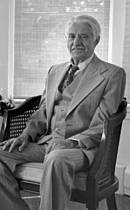Paul E. Anderson

Paul E. Anderson (1897-1983)
Paul Anderson was a pupil of Gurdjieff during the latter’s visits to America in the 1930s and 1940s, chosen by him to be his last secretary in the United States. Gurdjieff described Anderson and his spiritual level the following manner: “He not only has eaten one dog, but swallowed whole packs of dogs … and I rest very contented when I leave because you are my special American Secretary.” Gurdjieff visited Anderson in Washington DC, where he instructed him how to lead groups and gave him many of his manuscripts, which were meant for aid in teaching pupils.
After Gurdjieff’s death, Anderson continued his work in the Gurdjieff’s tradition, faithfully adhering to the Work in the manner that Gurdjieff had passed it on to him. Anderson and his wife were members of Orage’s group in New York until it was dissolved. An orthodox adherent of Gurdjieff’s tradition, Anderson, being one of the original members of the New York Gurdjieff Foundation, parted ways from it, continuing his work independently from it. He led a number of groups of pupils. His careful study of Gurdjieff’s “Beelzebub’s Tales to his Grandson” produced his Four Talks on “Time,” which he presented in May and June 1975. They demonstrated his approach of how “Beelzebub’s Tales” could be used as a textbook for practical application of Gurdjieff’s ideas. As Anderson stated, “One of the very greatest ‘secrets’ of this Work is connected with our experiences with Time and with its durations.” Anderson had great devotion to “Beelzebub’s Tales” and considered it the cornerstone for the Work, suggesting to his students to read and study it thoroughly.
Anderson was not a public figure, but kept to himself and to his work, which he continued with great focus. He intentionally obscured his own significance, revealing himself only to his closest students, only after having been convinced that they were prepared enough.
Anderson was highly acclaimed by other followers of the Gurdjieff tradition, including John Godolphin Bennett, who said about him: “…He is one of the very few who have attained the level of true teacher … the barakha has entered him.” Bennett mentioned Anderson in his book Gurdjieff: Making A New World. In the book he wrote that Anderson organized the first printing in a mimeographed edition of “Beelzebub’s Tales to his Grandson” in a run of 102 copies. He also indicated that Anderson made the initiative that the meeting took place between Gurdjieff and Senator of New Mexico Bronson Cutting, in which Gurdjieff planned to ask Senator Cutting to donate money to revive the Institute for the Harmonious Development of Man in France. Unfortunately, the meeting did not take place, since the airplane in which the Senator was flying exploded in mid-air and the Senator perished in the explosion. Anderson was also requested by Gurdjieff to contact the Soviet Embassy with the question of whether Gurdjieff would be allowed to return to Russia.
Towards the end of his life, Anderson began to be involved with Buddhism. He made connections with Tibetan Buddhist teachers, having met many lamas, who expressed the highest regard for him and his Work. He was especially involved with the Maha Siddha Nyingmapa Center in Hawley, Massachusetts. He made the acquaintance of the Dzochen Master, Namkhai Norbu Rinpoche, with whom he had a very close friendship and working relationship in his final years.
Paul Anderson died on February 24, 1983. After his death, two Tibetan lamas have written texts which they have dedicated to his memory – The Short Preliminary Practice of Long-chen Nying-Thig, by the Fourth Dodrup Chen Rinpoche, and The Cycle of Day and Night by Chögyal Namkhai Norbu.
Articles:





